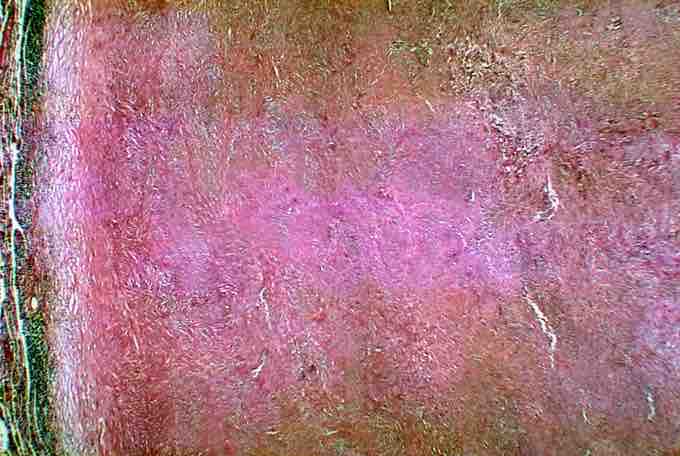Coccidioidomycosis (commonly known as "Valley fever", as well as "California fever", "Desert rheumatism", and "San Joaquin Valley fever") is a fungal disease caused by Coccidioides immitis or C. posadasii . It is endemic in certain parts of Arizona, California, Nevada, New Mexico, Texas, Utah and northwestern Mexico.

Coccidioidomycosis
Histopathological changes in a case of coccidioidomycosis of the lung showing a large fibrocaseous nodule.
C. immitis resides in the soil in certain parts of the southwestern United States, northern Mexico, and parts of Central and South America. It is dormant during long dry spells, then develops as a mold with long filaments that break off into airborne spores when the rains come. The spores, known as arthroconidia, are swept into the air by disruption of the soil, such as occurs during construction, farming, or an earthquake.
Infection is caused by inhalation of the particles. The disease is not transmitted from person to person. The infection ordinarily resolves leaving the patient with a specific immunity to re-infection. C. immitis is a dimorphic saprophytic organism that grows as a mycelium in the soil and produces a spherule form in the host organism.
The disease is usually mild, with flu-like symptoms and rashes. The Mayo Clinic estimates that half the population in some affected areas have suffered from the disease. On occasion, those particularly susceptible may develop a serious or even fatal illness. Serious complications include severe pneumonia, lung nodules, and disseminated disease, where the fungus spreads throughout the body. The disseminated form of Valley Fever can devastate the body, causing skin ulcers, abscesses, bone lesions, severe joint pain, heart inflammation, urinary tract problems, meningitis, and often death. In order of decreasing risk, people of Filipino, African, Native American, Hispanic, and Asian descent are susceptible to the disseminated form of the disease. Men and pregnant women, and people with weakened immune systems (such as from AIDS), are more susceptible than non-pregnant women.
It has been known to infect humans, cattle, deer, dogs, elk, fish, mules, livestock, apes, kangaroos, wallabies, tigers, bears, badgers, otters and marine mammals.
Symptomatic infection (40% of cases) usually presents as an influenza-like illness with fever, cough, headaches, rash, and myalgia (muscle pain). Some patients fail to recover and develop chronic pulmonary infection or widespread disseminated infection (affecting meninges, soft tissues, joints, and bone). Severe pulmonary disease may develop in HIV-infected persons.
An additional risk is that health care providers who are unfamiliar with it or are unaware that the patient has been exposed to it may misdiagnose it as cancer and subject the patient to unnecessary surgery.
Coccidioidomycosis may be divided into the following types: Primary pulmonary coccidioidomycosis; Disseminated coccidioidomycosis; and Primary cutaneous coccidioidomycosis.
The fungal infection can be demonstrated by microscopic detection of diagnostic cells in body fluids, exudates, sputum and biopsy-tissue. With specific nucleotide primers, C.immitis DNA can be amplified by PCR. It can also be detected in cultures by morphological identification, or by using molecular probes that hybridize with C.immitis RNA. An indirect demonstration of fungal infection can be achieved also by serologic analysis detecting fungal antigen or host antibody produced against the fungus.
There are no published prospective studies that examine optimal antifungal therapy for coccidioidomycosis. Mild cases often do not require treatment. Oral Fluconazole and intravenous Amphotericin B are used in progressive or disseminated disease, or in which patients are immunocompromised. Alternatively, itraconazole or ketoconazole may be used. Posaconazole and voriconazole have also been used. There is currently no practical preventative measures available for people who live or travel through Valley Fever endemic areas. It is recommended to avoid airborne dust or dirt, though this is not a guaranteed manner of prevention. People in certain occupations may be advised to wear face masks.